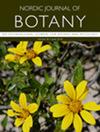Ecological niche modelling to project past, current and future distributional shift of black ebony tree Diospyros melanoxylon Roxb. in India
IF 1
4区 生物学
Q3 PLANT SCIENCES
引用次数: 0
Abstract
The present study utilized an ensemble modelling approach to predict the distribution of Diospyros melanoxylon under present, past (last glacial maximum (LGM), ~ 22 000 years BP, middle Holocene (MH) ~ 6000 years BP) and future climate change scenarios (RCP 2.6 and 8.5 for 2050s and 2070s). The annual mean temperature, mean temperature of the wettest quarter and annual precipitations were the most critical parameters that chiefly influence the distribution of D. melanoxylon. The ensemble model rendered high accuracy with AUC = 0.93, TSS = 0.74 and Kappa = 0.71. Past projections of D. melanoxylon indicated a widespread distribution during LGM and MH suggesting its adaptability to semi-dry as well as warm and humid climate, respectively. Presence of fossil pollen evidence of D. melanoxylon in the suitable habitats derived through past projections in this study complements the model results and marks occurrences of the species during LGM and MH. By 2050s and 2070s (RCP 8.5), there would be a decline in the distribution by only 0.4% (13 622 km2) and 0.2% (6842 km2) of the extremely suitable habitats, respectively. The main factor leading to reduced habitat suitability is the anticipated rise in temperature and variations in seasonal precipitation patterns. Our findings, help in identifying the parts of the country which would be severely affected by future climate change scenarios and plan conservation strategies for this commercially important species to facilitate its growth in suitable habitats which are likely to sustain under future climatic conditions.通过生态位建模预测印度黑乌木过去、现在和未来的分布变化
本研究采用集合建模方法,预测了在现在、过去(末次冰川最大值(LGM),约公元前 22 000 年,全新世中期(MH),约公元前 6 000 年)和未来气候变化情景(RCP 2.6 和 8.5,2050 年代和 2070 年代)下黑杨的分布。年平均气温、最潮湿季度的平均气温和年降水量是影响黑线鲃分布的最关键参数。集合模型的准确度很高,AUC = 0.93,TSS = 0.74,Kappa = 0.71。过去的预测表明,D. melanoxylon在LGM和MH时期分布广泛,这表明其分别适应半干旱和温暖湿润的气候。在本研究中,通过过去预测得出的适宜栖息地中存在 D. melanoxylon 的化石花粉证据补充了模型结果,并标志着该物种在 LGM 和 MH 期间的出现。到 2050 年代和 2070 年代(RCP 8.5),极其适宜的生境分布将分别减少 0.4% (13 622 平方公里)和 0.2% (6842 平方公里)。导致栖息地适宜性下降的主要因素是预期的气温上升和季节性降水模式的变化。我们的研究结果有助于确定该国哪些地区会受到未来气候变化的严重影响,并为这一具有重要商业价值的物种规划保护战略,以促进其在未来气候条件下可能维持的适宜栖息地中生长。
本文章由计算机程序翻译,如有差异,请以英文原文为准。
求助全文
约1分钟内获得全文
求助全文
来源期刊

Nordic Journal of Botany
生物-植物科学
CiteScore
1.90
自引率
11.10%
发文量
100
审稿时长
2 months
期刊介绍:
Nordic Journal of Botany publishes original contributions on all aspects of the taxonomy, evolution, conservation, ecology and biogeography of plants (including algae and bryophytes) and fungi.
 求助内容:
求助内容: 应助结果提醒方式:
应助结果提醒方式:


